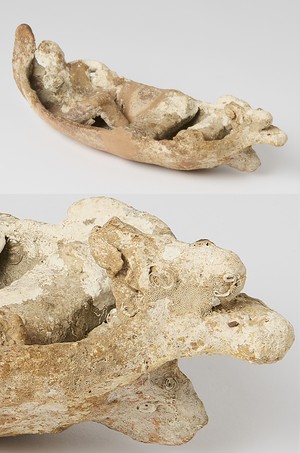Cypriot or Phoenician Model small boat with figure: Cypro-Archaic II (600-480BC)
Probably missing two figures, plus most of the steersman’s right arm. Encrusted in places by remains of bryozoans and other marine growths. Mended from several pieces. The principal mend is below the boatman’s feet, rising each side in a Y shape, a strip of restoration follows each branch. When overpainting was removed, it was found the outside of the left triangle thus defined had been scraped by earlier restorers, removing the marine encrustation. (DJ 268 AN 248)
The boat was probably intended as a votive offering at a coastal shrine, much like the model ships now hung in some churches. The adhering marine growths suggest it was cast into the sea as a votive offering to Asherah Tanit (Astarte) on the Phoenician coast, or the Great Goddess of Cyprus, or possibly Heracles/Melqart (see 263 & Brody). The reappearance of Cypriot boat offerings in the 7thto 6th century BC probably relates to Phoenician involvement in Cypriot trade. Many small ship models have been found at Amathus in tombs and shrines, though most of those represent larger ships not containing figures. The old Archaic harbour is now inland but the Andikat project mentions ship models found at Amathus in the sea. Small model boats with figures, such as this, have mostly been found on the East coast near Salamis/Famagusta. Coastal erosion or sea-level rise since 600 BC has been less than a metre.Similar small Phoenician ship-models have also been found outside Cyprus, especially by the Lebanese coast. The model probably originally had painted detail.
A figure, probably the steersman, reclines on a thwart by the sternpost, and might represent the donor, thus putting him under the protection of the deity. His left arm bent and projecting beyond the gunwale. On the two thwarts further forward are scars probably indicating the arms of two(?) missing figures of rowers, the large foot well suggesting they faced backwards. Within the projecting prow is an object hard to identify: possibly an animal head (horses heads on prows are known from Phoenician examples). Below it, on the underside is a vertical flat projection, extending from the prow - probably a cutwater.
TL test by Oxford Authentication dated the boat as 850-1250 CE, but it is now known to have been in a recent house-fire. Oxford Authentication confirm partial TL date reset is possible ca.200-300ºC.
Cf. V Karageorghis 1995, Pl LXXV (7)– LXXVII, p.128-131; V Karageorghis 2006 p186, 189; E Galili et al 2016 p217; Caroline Sauvage 2025 p.21-32; Brody A. 1998
Size: 24.5cm long
(Dispersal of large collection from Cambridge bought mainly from well known Auction houses, then by descent.)
(Aquired Acquired by DJ: Timeline Auction 5th March lot 0052)
(DJ 269 AN 249)

